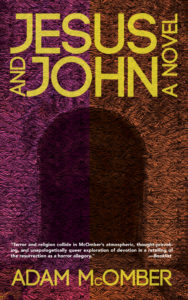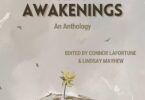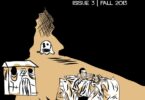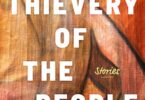Adam McOmber, Jesus and John: A Novel (Lethe Press, 2020), 236 pp., $15 USD.
Adam McOmber’s novel Jesus and John is a rare matryoshka doll of a horror novel. It is a queer love story inside a historical recreation of Jesus fraternizing with the Apostle John inside a cosmic horror story seen through a lens of Gnosticism.
The Los Angeles-based Adam McOmber has availed of himself well in the milieu of fantastic speculative fiction, sometimes spooky, and at times re-interpreting Scripture, with the short-fiction collection My House Gathers Desires: Stories (BOA Editions, 2016), The White Forest: A Novel (Touchstone, 2012) and This New & Poisonous Air (BOA Editions, 2011). He teaches in the MFA Writing Program at Vermont College of Fine Arts.
In Jesus and John, McOmber evokes a religious horror, giving a new perspective on the New Testament and Gnostic Gospels. Billing the work as an allegory also gives McOmber free reign to re-write the Apostles, use the first-person voice to show the interior life of John, and to zombify Jesus while not making the Son of God outrageously queer. A beat of cosmic dread builds throughout, careening into Gnosticism that becomes convoluted at times and yet culminates in a third act that is particularly repulsive for uninitiated readers.
McOmber positions his story just before the widespread arrival of Christianity, particularly in Western Europe, when polytheism and paganism were dominant, telling it through a Gnostic lens rather than a Judeo-Christian one. Gnosticism (from Ancient Greek, meaning “having knowledge”) originated in the first century AD among early Christian and Jewish sects, emphasizing personal spiritual knowledge or gnosis over orthodox teachings and the authority of the Church. Gnostic writings flourished among certain groups in the Mediterranean world until the second century, when the early Church denounced them as heresy. Its efforts to destroy these texts proved largely successful. Very little writing by Gnostic theologians survives as a result.
McOmber has seemingly loosely based his tale on The Secret Book of John, also called the Apocryphon of John or the Secret Revelation of John, a second-century Sethian Gnostic Christian text of secret teachings that describes Jesus appearing and giving secret knowledge (gnosis) to John the Apostle.
Gnostics, who were at loggerheads with orthodox Christians from the outset, considered the principal element of salvation to be direct knowledge of the supreme divinity in the form of mystical or esoteric insight. For Gnostics, salvation came through knowledge of self. For Christians, salvation was through faith in the risen Christ. Gnostics were dualists, worshipping two or more gods. Christians were monists, worshipping one. Many Gnostic texts deal not in concepts of sin and repentance, but with illusion and enlightenment. Gnostics view material existence as flawed or evil. The Gnostic cosmogony generally distinguishes between a supreme, hidden God and a malevolent lesser divinity, the Demiurge (sometimes associated with the Yahweh of the Old Testament) who shaped the material universe, but is not necessarily its creator.
Jesus and John opens with a classical horror hook. A disconcerted Mary Magdalene tells the apostles Peter and John that something is stirring in the tomb where they recently interred Jesus or Yeshua. The name Jesus, it should be noted, is derived from the Hebrew name Yeshua/Y’shu, which McOmber uses throughout. They inspect and witness Yeshua rising from the dead, their uncomprehending horror worthy of any zombie fiction:
I peered into the shadows too and saw, standing there, a tall gaunt figure draped in the length of a burial shroud. Funeral oils stained the shroud. And the boney form swayed from side to side, as a blade of tall grass might sway in a gentle wind.
“What is that, John?” Peter asked.
I didn’t reply, though I knew the answer well enough. I recognized the man who stood there in the corner of the tomb, even though His features were hidden.
“John,” Peter said again. “Who stands there in the shadows?”
The figure shifted, twitching its hands.
“Yeshua,” I said softly.
Peter made a low sound at the back of his throat, the growl of a frightened animal. “How do you know it’s Him?”
“The way He stands,” I said. “The way He moves.” But, in truth, I simply knew Him. I’d lain with Him, touched His contours in the dark.
This listless Yeshua terrifies even Peter, normally the aggressive soldier. Fearful of others seeing this shambling figure, they frantically make a plan. John will sneak Yeshua away under the cover of night. Yeshua then leads John on a pilgrimage from Galilee to Rome to the Grey Palace, a house that is more than a house, where a cult intends to use Yeshua for its nefarious reality-bending purposes.
Allegory allows McOmber much leeway in retelling the story of pre-Christianity. He plays with many of the toys in the New Testament and Gnostic sandboxes including the Apostles, with their separate ambitions, and Yeshua’s attempts to impart wisdom.
McOmber’s use of the first-person voice, a daring move for any novelist, gets readers inside John’s head, capturing his fears, doubts and loves. While the pilgrimage moves forward, through subtly interwoven, textured flashbacks, McOmber even reveals Peter and Yeshua’s love affair. More on Peter later.
McOmber portrays Yeshua as the perfect man learning to live among the human race and appears careful about not straying too off-trail or off-Scripture in portraying Yeshua’s queerness and the other apostles’ acceptance of him. Most of the group of twelve do not appear to condone the affair, but neither do they appear to disapprove, except Peter, who is demonstrably disgusted by John’s queerness. To them, Yeshua is simply an incomprehensible figure. They let the relationship discretely unfold behind closed doors. Featuring a queer John whom the other disciples tacitly accept is revisionist, a clear deviation from mainstream Christianity’s depictions of Christ, almost a wish fulfillment for those who dared admit attraction to the striking figure. McOmber’s Yeshua is notably quiet about his own queerness.
That McOmber’s Yeshua is a listless zombie is a clever literary MacGuffin. In Jesus and John, before resurrection, Yeshua embraced same-sex love, brotherly love and all love. However, there is uncertainty about how much Yeshua consciously gets involved with John, which may discomfit readers. Yeshua is confused, easily influenced, malleable. However, as an inchoate zombie, Yeshua never goes off-script (or Scripture?). He never, for example, espouses love for John. In this way, McOmber spins a fanciful, yet horrific What-if? story without making Yeshua too outspokenly queer.
His apostles are dedicated, wanting to spread the word of the Son of God, as in mainstream Christianity, and discretely accept Yeshua even though they do not understand him. It’s an interesting subversion of spreading the good news, as it were. In Yeshua’s sermons, he reveres a great city that he wishes to return to where he will reunite with his father. The sermons are equated with manna. The manna transfixes and elevates the apostles, but they almost always immediately forgot it afterward, like a dream upon waking. Peter is the exception, liberally interpreting for Yeshua on the mound. Afterwards, Peter willfully misinterprets the sermons to enforce and expand his own military strategies, ultimately serving his own self-interests. Yeshua’s followers, including his interpreter, don’t understand his teachings, but feel the compulsion to share their interpretations of the teachings for personal gain.
McOmber’s Yeshua is not the Jesus of the King James Bible, the New World Translations of the Holy Scriptures or the Book of Mormon. In his lens, Yeshua is a free-loving and misunderstood spiritual leader in charge of faithful but confused disciples. Yeshua is also essentially zombiefied for most of the book, reducing John to either babysitter or blind follower. Yeshua is of no help, except as guide, until the third act.
In contrast to Yeshua’s exterior blank slate, the quiet, interior queerness of John is unquestionable, very much alive. The apostle is always honest with himself, recalling other lovers, and even open to new partners. He has an unexpected dalliance with a beefy Roman soldier, which one can read many ways, as lovers in a desperate time, fan fiction, allegory or straight-up queer erotica.
But this queer love story is also shot through with a cosmic dread that implies the human race’s place in the universe is rather negligible and controlled by outward forces. The reader, like John, is on unsure footing for most of the pilgrimage. John explores the Grey Palace, a house that does not abide by the laws of physics, finding a sort of large diorama of the palace and ultimately a cityscape of empty temple-houses and stalking horrors reminiscent of the Cenobites from the Hellraiser films:
At that sound, the creature stirred, twitching one of its rudimentary arms and then a leg. I thought of Yeshua and of Gallus. I thought of what I had done in the temple-house. In the beginning, there was emptiness and there was darkness.
The worm lifted its human-like head. Its mirror dark eyes reflected the light of my oil lamp. The worm opened its mouth. Its maw was full of human teeth, and it made a sound like a dog and a bird. Like both animals screaming at once. And the creature scrambled to right itself. To come for me.
The third act leans heavily on Gnostic beliefs about reality, after disparate clues and muddied waters that could possibly leave behind readers unfamiliar with this belief system. In layperson’s terms, a cult wants Yeshua to awaken the Grey Lady, or Sophia, an Aeon or angel-like figure, so she can unbind the reality fashioned by the Demiurge, because this reality, our reality, is a lie. The Demiurge is characterized as an artisanal-like being who maintains reality. Alternatively, the cult could be under the Demiurge’s thrall and the Demiurge wants to warp reality.
A further note on Gnosticism might be helpful, here. Yeshua is an Aeon or a lesser emanation of the One (one of the names for the Supreme Being, which also emanated the Holy Spirit). Aeons have many similarities to Judaeo-Christian angels. The female Aeon Sophia emanates without her partner Aeon, resulting in creating the Demiurge, a creature that should never have been. The material with which the Demiurge fashioned the universe (and the Demiurge itself) may be uncreated and eternal, or the product of some other entity.
To a non-initiated reader, either unbinding reality or changing reality and shifting the cosmic order may sound equally and mind-bendingly repulsive. However, McOmber is, in fact, riffing on Gnostic gospel. While the palace and its cult could be fictional, most of these other elements are part of a clever setup that plays on Gnostic beliefs. Unbinding reality seems like a bad thing from our human perspective, but the Gnostic belief is that Sophia will release what is trapped within us so that those fragments may rejoin the pleroma or wholeness.
Amid all this cosmos-bending horror, McOmber does well to circle back to a Stephen King-esque point of recurring and imprinted trauma. John is consumed by how he witnessed a crucified Yeshua murdered at the hands of Roman soldiers in Jerusalem, on top of a hill of bones. Such grisly imagery, incorporating a religious figure, is notably hard to shake. Still, allegory, revisionist Apostles, and Zombie Yeshua aside, it is John’s interior life that is the true quest, driving the narrative and engrossing the reader. With this macabre tableau of Yeshua’s murder as a literary device along with John’s vivid interior life and longing for love and acceptance from Yeshua, McOmber marries a fanciful queer love story with reality-obfuscating horror. While the Gnosticism may not leave enough clear clues for some, readers can find recompense in John’s first-person love daring to speak its name. The pilgrimage, both queer and cosmic, is worth travelling, for its sheer audacity.
 James K. Moran is a freelance journalist, novelist and poet living in Ottawa. His articles have appeared via CBC Radio, Lambda Literary, Rue Morgue and Daily Xtra, where he wrote for over 15 years, starting when it was called Capital Xtra! Moran’s speculative fiction and poetry have appeared in Canadian, American and British publications including Icarus, On Spec and Glitterwolf. He blogs at jameskmoran.blogspot.ca and is findable at @jkmoran. Town & Train (Lethe Press, 2014) is Moran’s debut horror novel. Right now, he should really be revising his second one.
James K. Moran is a freelance journalist, novelist and poet living in Ottawa. His articles have appeared via CBC Radio, Lambda Literary, Rue Morgue and Daily Xtra, where he wrote for over 15 years, starting when it was called Capital Xtra! Moran’s speculative fiction and poetry have appeared in Canadian, American and British publications including Icarus, On Spec and Glitterwolf. He blogs at jameskmoran.blogspot.ca and is findable at @jkmoran. Town & Train (Lethe Press, 2014) is Moran’s debut horror novel. Right now, he should really be revising his second one.







